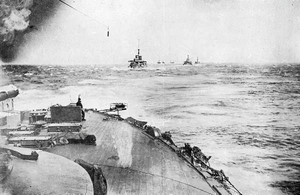| This article needs additional citations for verification. Please help improve this article by adding citations to reliable sources. Unsourced material may be challenged and removed. Find sources: "Japanese occupation of German colonial possessions" – news · newspapers · books · scholar · JSTOR (August 2014) (Learn how and when to remove this message) |
| Japanese occupation of German colonial possessions | |||||||||
|---|---|---|---|---|---|---|---|---|---|
| Part of the Asian and Pacific theatre of World War I | |||||||||
 Japanese Warships traveling the ocean. | |||||||||
| |||||||||
| Belligerents | |||||||||
|
| |||||||||
| Commanders and leaders | |||||||||
| Strength | |||||||||
|
| ||||||||
| Command of the Oceans 1914–1917 | |
|---|---|
| Military campaigns of the Empire of Japan | |
|---|---|
| Meiji period |
Japan joined World War I in order to acquire Pacific colonies. During October 1914, the Japanese sent vessels to occupy German colonies in the Mariana, Marshall, Palau and Caroline Islands. These islands were later used for strategic advantage in World War II.
Background
Japan joined the war since they were already in an alliance with the British Empire and wanted to gain more territories. Japan joined the war on August 23, 1914, and attacked German colonies in China on August 27.
Actions
- Japanese aggression
During World War I, Japan was in an alliance with Britain and decided to go to war with Germany. Japan started to besiege German possessions in China at first. Japan then sent the Imperial Japanese Navy out to the Pacific islands held by the Germans. The British however were annoyed by the Japanese aggression in the Pacific as they told them not to attack them.
- German defenses
Germany did not plan on defending the islands, since they did not think that they would be attacked. When the Japanese invaded the islands, German officers, police and locals would have small clashes which did not stop the Japanese invading the islands. One example of resistance was on the Micronesian island of Ponape, where a District Officer, two Polizeitruppe NCOs and 50 Melanesian Polizeitruppe who retreated into the forests. Another example was when the crew of the SMS Planet tried scuttling the vessel at the entrance of the harbor on Yap attempting to stop Japanese ships from getting in. A third example was when a sergeant on the island of Saipan rebelled against the Japanese marines that were landing by rallying the local police force and resist them on the beach.
Japanese Occupation
The navy minister told Japanese commanders not to occupy any islands. Tanin Yamaya disobeyed the order and occupied Jaluit Atoll on September 29. The navy ministers told him to reverse the military occupation of the island but changed their mind after seeing that the islands were otherwise unoccupied. The island was later reoccupied on October 3. After that on Oct. 5, Japan would occupy Kosrae. The Japanese then proceeded to occupy the other islands as the United Kingdom didn't react. Ponape in the Caroline's was captured on Oct. 7, although the territory’s surrender was delayed a few days due to a small local defence force that hid in the island’s interior to mount a resistance. They later realized their situation was hopeless and gave up. The Caroline islands of Yap also fell on October 7 and the only tensions there were the shelling, destruction of the wireless station and the scuttling of the SMS Planet, followed by the occupation of Koror on October 8, Angaur on Oct. 9. Truk Atoll was captured on Oct. 12, Saipan on October 14 while encountering minuscule resistance, and Rota October, 21st. In less than a month all of German New Guinea's islands were occupied by Japan beside Nauru.
Aftermath
- After occupation
After the Japanese had occupied the German islands, they were not faced with any rebellion of some sort.
- South Seas Mandate
Following the initial Japanese occupation of the islands, a policy of secrecy was adopted. Japan made it plain that it did not welcome the entry of foreign ships into Micronesian waters, even those of its wartime allies. This was known as the South Seas Mandate.
References
- "USNI.org".
- ^ MilitaryHistoryNow.com (17 February 2022). "The Capture of German Micronesia — How Swift Action in 1914 Secured Japan a South Pacific Empire". MilitaryHistoryNow.com. Retrieved 28 December 2023.
- "Japan gives ultimatum to Germany | August 15, 1914". HISTORY. Retrieved 28 December 2023.
- MilitaryHistoryNow.com (17 February 2022). "The Capture of German Micronesia — How Swift Action in 1914 Secured Japan a South Pacific Empire". MilitaryHistoryNow.com. Retrieved 28 December 2023.
- https://www.usni.org/magazines/naval-history-magazine/2021/june/japans-victory-world-war-i.
{{cite web}}: Missing or empty|title=(help) - "1914-1918 encyclopedia".
- "German Colonial Uniforms". www.germancolonialuniforms.co.uk. Retrieved 3 February 2024.
- "Pacific Islands - Colonialism, WWI, Melanesia | Britannica". www.britannica.com. 21 July 2024. Retrieved 22 July 2024.
- "Pacific Worlds".
- "MSP No. 63 – SMS Planet | GermanStamps.net". Retrieved 14 July 2024.
- "Pacific Islands - Colonialism, WWI, Melanesia | Britannica". www.britannica.com. Retrieved 28 December 2023.
- "Pacific Islands | International Encyclopedia of the First World War (WW1)".